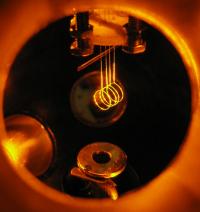Physicists Put A New TWIST On Ultra-cold Molecular Research
Rochester (NY) - Physicsts at the University of Rochester have created an extremely simple, elegant device which can capture generated ultra-cold polar molecules by the truckload. The new device greatly simplifies an existing complex process that, according to the report, only four labs in the world were capable of performing. This new process is not only faster and less costly, but it also results in a continuous, near perfect yield of their desired molecules. Scientists believe this ability will help them develop exotic crystals and eventually stable quantum computers.
The team had to play around with the tungsten wire thickness during research stages to determine a delicate balance. Since the tungsten is ultimately cooled to a temperature near to absolute zero, it had to be strong enough to withstand forces at that temperature, yet thick enough to produce the desired electrical effects. The physicists finally settled on a thickness that is just about that of a human hair. It wasn't too brittle, yet provided enough magnetic/electrical effects to be useful.
The device is the first "electrostatic polar molecule trap" that works with a simultaneous "magneto-optical atom trap" (MOT). The MOT contains lasers used to cool the atoms to a few millionths of a degree above absolute zero. They're then forced into the desired molecules by a process called photoassociation. The new molecules created by this process have a slight positive charge. This allows them to be instantaneously held in place by the electrostatic effect, a quantum peculiarity which basically directs the super-chilled molecules along the magnetic gradient to a point at the center of the tungsten loop's electric field. This movement of the slightly positively charged molecules also has the effect of letting any non-polar molecules which might be nearby simply drift away. This accounts for its high yield.
According to Jan Kleinert, a leading physicist who helped develop TWIST, "The coldest molecules so far have been produced from MOTs [which were stand alone devices], but until the TWIST came along, electric field trapping and MOTs just didn't go together. Now we can accumulate these polar molecules continuously, without switching from creation to storage and back again. With a good supply of ultracold polar molecules, computer scientists would have a new tool with which to tackle the creation of quantum computers."
The release states, "quantum computer scientists are attracted to ultracold particles because their temperatures reduce decoherence, a phenomenon where your system decays from the carefully prepared quantum configuration you started with, to a classical physics state, which loses all the advantages quantum computers hold."
Benefits
Scientists will also use the technology to examine a largely unanswered area of physics research, namely that of electron configuration. The question remains about whether or not electrons have a definite, fixed size, or whether they are dimensionless points. There are several models which support different configurations, and this new research may produce a stable environment for new tests which will answer those questions.
The TWIST was developed by Nicholas P. Bigelow, the Lee A. DuBridge Professor of Physics at the University of Rochester. Additional researchers assisted professor Bigelow, including Jan Kleinert, a doctoral physics student.
Get Tom's Hardware's best news and in-depth reviews, straight to your inbox.
